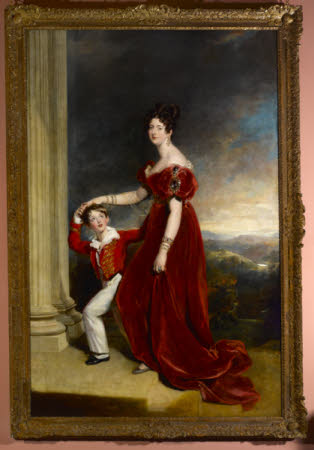Frances Anne, Marchioness of Londonderry (1800-65), and her son, George Henry, Viscount Seaham (1827- 28)
Sir Thomas Lawrence, PRA (Bristol 1769 – London 1830)
Category
Art / Oil paintings
Date
circa 1827 - 1828 (exh at RA)
Materials
Oil on canvas
Measurements
2965 x 2055 x 110 mm
Place of origin
England
Order this imageCollection
Mount Stewart, County Down
NT 1542446
Caption
Considered to be one of the most beautiful and talented women of her generation, Frances Anne, Marchioness of Londonderry (1800–65), is shown in this portrait with her playful young son George. What does the portrait tell us about her character and social position? Her husband Charles Stewart, 3rd Marquess of Londonderry (1778–1854), was a key patron of Sir Thomas Lawrence (1769–1830), a fashionable portrait painter of this period. Lawrence spares no effort in depicting Frances as every inch the wealthy, aristocratic heiress and elegant wife and mother by posing her in a sumptuous red-velvet gown pinned with rare jewels. It is significant that she chose to be presented on the threshold of her own house, Wynyard Hall in County Durham, the estate she brought to her marriage. Her evident confidence and poise as she is led up the steps seem to invite viewers into the picture. Later in life she became one of Britain’s first female industrialists by taking charge of the family coal-mining business.
Summary
Oil painting on canvas, Frances Anne, Marchioness of Londonderry (1800 - 1865) and her Son George, Viscount Seaham, later 5th Marquess of Londonderry (1821 - 1884) by Sir Thomas Lawrence, PRA (Bristol 1769 – London 1830), 1828. Double full-length portrait of the wife of Charles, 3rd Marquess of Londonderry and their son George, Viscount Seaham, later the 5th Marquess, on the steps of Wynyard Park, County Durham, overlooking the landscape, she in a long red velvet dress with a train and wearing jewellery (including the amethyst sleeve clasps which were a gift from Tsar Alexander I of Russia), he in a red military jacket and white trousers.
Full description
This arresting picture, undoubtedly one of Lawrence’s finest female portraits, was begun in 1827 and exhibited at the Royal Academy summer exhibition the following year. It depicts Frances Anne, Marchioness of Londonderry, on the steps of her family seat Wynyard Park in County Durham. Gazing directly at the viewer, she wears a sumptuous crimson velvet dress with enormous amethyst clasps. The richness of the gown emphasises her porcelain skin and the weightless elegance of her elongated neck and arms, her right arm being gently tugged by her son George, who is eager to lead her inside. With rosy-red cheeks, bright eyes and flaxen hair, George’s energy delightfully contrasts his mother’s relaxed poise. In the background the 7,000-acre Wynyard estate leads the eye towards the North Sea, which can just be made out in the horizon. Frances Anne was the second wife of Lawrence’s close friend and long-term patron, Charles William Vane-Stewart, 3rd Marquess of Londonderry. She was enormously wealthy, having inherited extensive lands and coalmines in the northeast of England from her father Sir Henry Vane-Tempest (1771-1813). Charles Stewart, ambassador to Vienna from 1814 to 1823, was a fourty-year-old widower with an heir (Frederick, NT 1542326, 1542318) when the couple met in 1817. Initially concerned by this, Frances Anne would secure titles and inheritance for her future son George when, in 1823, Charles was named Earl Vane (a stipulation of Sir Henry’s will) and Viscount Seaham in the peerage. This double portrait can therefore be read as a dynastic image, underscoring Frances Anne’s contribution to the succession and wealth of the Marquisate of Londonderry. She enabled them to acquire the Seaham estate in County Durham, Holderness House in London (later renamed Londonderry House), and to rebuild Wynyard on a grand scale. Charles also was able to extend Mount Stewart, his principal seat in Ireland. The couple lived a lavish lifestyle at home and abroad, travelling extensively in Europe and Russia. It was there that Tsar Alexander I, smitten with Frances Anne’s beauty and elegance, gave her the massive Siberian amethysts seen here suspended from the puff sleeves. After its debut at the Royal Academy the picture was brought to Wynyard Park, from where Charles wrote to Lawrence, ‘Your beautiful picture is safely arrived...It is [impossible] for me to describe adequately the effects and improvements it [renders]...Everybody is enchanted with it’ (RA LAW/5/262).
Provenance
By family descent; accepted by HM Government in lieu of inheritance tax and allocated to the National Trust for display at Mount Stewart, 2015.
Makers and roles
Sir Thomas Lawrence, PRA (Bristol 1769 – London 1830), artist
References
Armstrong, 1913: Sir Walter Armstrong, Lawrence, London, 1913, p. 148 Garlick 1989 Kenneth Garlick, Sir Thomas Lawrence. A complete catalogue of the oil paintings, Oxford, 1989, no. 510 (b) Levey 2005 Michael Levey, Sir Thomas Lawrence, New Haven and London, 2005, pp. 283 and 287, pl. 152 Sir Thomas Lawrence 1769 - 1830 (exh cat) (ed. Michael Levey) National Portrait Gallery, London, 9 November 1979 - 16 March 1980, no. 48, p. 80 De Bruijn 2015 Emile de Bruijn et al, 'Acquisitions' in National Trust Historic Houses & Collections Annual (Apollo), 2015, pp. 57 - 66

